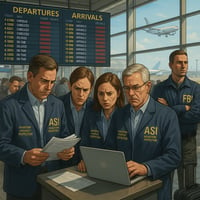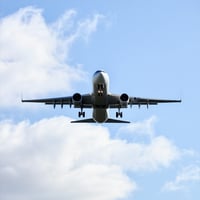Why Doesn’t the FAA Have a Law Enforcement Arm—And Is It Making Aviation Less Safe? In the complex...
Safe Enough for Baby Ducks, Safe Enough for Airplanes: Dawn Powerwash and the Aviation Cleaning Question
Safe Enough for Baby Ducks, Safe Enough for Airplanes: Dawn Powerwash and the Aviation Cleaning Question
Introduction: From Kitchen Sink to Hangar Floor
Every aircraft owner knows the battle: soot-streaked nacelles, oil-slicked bellies, and the stubborn black fingerprints of exhaust stains clinging to paint and aluminum. Aviation is an industry of meticulous standards, and nowhere is that more visible than in how an airplane looks when it rolls out of the hangar. But behind the shine is a constant maintenance chore—and often, a hefty bill for specialty cleaners and compounds marketed exclusively to aviation.
That’s why one of my most surprising discoveries didn’t come from an aviation catalog at all. It came from the grocery store. Specifically, from a little blue spray bottle most people keep next to their kitchen sink: Dawn Powerwash Dish Spray.
What began as a half-joking idea—“If it’s safe enough for baby ducks, it’s safe enough for airplanes”—turned into one of the most effective and economical cleaning solutions I’ve ever used in aviation.
The Backstory: A Stain Too Stubborn
It started with my Cessna 414. The gear doors were streaked with baked-on exhaust stains, a familiar nuisance to any owner of piston twins. I had tried the usual suspects: aviation-branded belly soap, degreasers, and even gentle solvents, each with limited success. Some were effective but raised questions about corrosion. Others simply didn’t touch the residue at all.
One day, standing in the hangar and frustrated, I considered the bottle of Dawn Powerwash I had used at home. My business partner raised an eyebrow when I mentioned it. “You really want to put dish soap on an airplane?” he asked. Our shared concern was obvious: what if it was corrosive?
That’s when I cracked the now-famous joke: “Well, if it’s safe enough for baby ducks, it’s safe enough for airplanes.”
Seconds later, still on speakerphone, I called my friend Eric—an Army NCO and seasoned helicopter repair professional. Without any prompting beyond the words “Dawn Powerwash,” Eric laughed and replied: “Safe enough for baby ducks, safe enough for helicopters.” The timing was perfect. My partner and I burst into laughter. Then Eric added something that changed the tone entirely: “We buy it by the gallon.”
Here was a career maintenance professional, working daily on multi-million-dollar helicopters, confirming that the product wasn’t just safe—it was already being used in military hangars. That was enough for me to give it a shot.
The First Test: From Joke to Reality
I sprayed the foaming cleaner directly onto the gear doors. The blue foam clung to the stains, seeping into the carbon and oil mixture that had resisted every other cleaner. Within seconds, I wiped with a soft cloth. To my surprise, the stain lifted easily, leaving behind clean paint without dulling or streaking.
It wasn’t just effective—it was effortless.
That was the moment I realized this wasn’t just a funny experiment or a clever shortcut. Dawn Powerwash had genuine aviation potential.
Why Aircraft Cleaning Matters
To understand why this matters, it helps to look at why cleaning airplanes is more than cosmetic. Unlike cars, where dirt is mostly aesthetic, grime on an airplane can conceal cracks, corrosion, or fluid leaks. Exhaust staining in particular can mask oil leaks, exhaust leaks, or structural issues.
1. Inspection Integrity
A clean aircraft is easier to inspect. Mechanics rely on spotting subtle signs of trouble. A streak of oil could be the difference between catching a cracked cylinder early or experiencing a catastrophic engine failure later.
2. Corrosion Prevention
Oil, exhaust soot, and de-icing fluids can trap moisture and salts against aluminum, accelerating corrosion. Regular cleaning is as much a corrosion-prevention program as it is about pride of ownership.
3. Drag and Efficiency
Bug splatter on leading edges and residue on wings doesn’t just look bad—it affects aerodynamics. Even small increases in drag translate to higher fuel burn.
4. Resale Value and Image
For owners who plan to sell, appearance matters. A gleaming aircraft inspires buyer confidence. For commercial operators, image translates directly into customer trust.
Given these stakes, finding cleaners that are both effective and safe isn’t optional—it’s critical.
The Cleaner Landscape: Aviation vs. Household
The aviation aisle is full of specialty products—belly soaps, exhaust stain removers, bug cleaners—each promising aircraft-safe cleaning. But the price tags are steep, often five to ten times higher than consumer alternatives. And ironically, many are variations of the same surfactant technology found in household cleaners.
What Aviation Cleaners Promise
- Non-corrosive formulas
- Paint-safe performance
- Biodegradable runoff
- Aviation-specific branding
The Problem
Despite the branding, not all aviation cleaners outperform consumer products. Some are relabeled industrial degreasers with markup. Others require aggressive scrubbing, risking scratches on delicate paint.
So the question becomes: if a household cleaner can match or exceed performance—and is proven safe—why shouldn’t pilots and mechanics use it?
Why Dawn Powerwash Works
At its core, Dawn Powerwash is designed to cut through grease, oils, and carbon-based residues—the same kinds of grime that coat an aircraft’s belly and engine areas. Its foaming spray clings to vertical surfaces, giving the surfactants time to work.
Key Advantages for Aviation Use
- Non-Corrosive: Safe for aluminum, paint, and stainless hardware.
- Foam Cling: Reduces scrubbing effort on stubborn stains.
- Oil & Exhaust Removal: Designed for greasy dishes, equally effective on exhaust carbon.
- Cost & Availability: Inexpensive and found at any grocery store.
Expert Insight: Military Maintenance and Common Sense
Eric’s endorsement wasn’t a fluke. Military helicopter units routinely use Dawn products for degreasing. The U.S. Army and Air Force have documented use of Dawn dish soaps for cleaning aircraft components, precisely because of their gentle yet effective surfactant profile.
This highlights an important principle: aviation doesn’t always require exotic products. Sometimes the simplest, safest solution is already sitting on the shelf.
Cautions and Best Practices
While the anecdotal and practical evidence is strong, aircraft cleaning always comes with caveats:
- Avoid Sensitive Areas: Do not spray into pitot-static ports, avionics cooling inlets, or brake assemblies.
- Rinse Thoroughly: Even non-corrosive cleaners should be rinsed with fresh water to prevent residue.
- Test First: Always test on a small area of paint or composite before full use.
- Follow Manufacturer Guidance: Until formal comment is provided, owners should treat this as off-label use.
The Manufacturer’s Perspective
In preparing this article, I reached out to Procter & Gamble, the parent company of Dawn, to request comment on material compatibility, corrosion testing, and whether they have an official position on aviation use. As of publication, P&G has not responded to multiple requests for comment.
This absence of response should not be interpreted as either endorsement or disapproval. Rather, it underscores the reality that aircraft owners venturing into consumer products for maintenance solutions are moving into off-label territory, where professional judgment and caution are paramount.
Sidebar: What Dawn Says — No Response Yet
In preparing this story, we contacted Procter & Gamble to ask specific questions about Powerwash Dish Spray and its potential use on aircraft. Our questions covered:
- Whether the formula is non-corrosive to common aircraft materials (aluminum, composites, paint, rubber seals).
- Any testing against ASTM or transportation industry standards.
- Best practices or cautions for off-label applications like aviation cleaning.
- Whether P&G wished to endorse, discourage, or remain neutral on such use.
As of publication, P&G has not responded to multiple requests for comment.
This silence should not be taken as endorsement or rejection of the product’s use on airplanes. It does, however, underscore that owners experimenting with consumer cleaners in aviation are operating outside of manufacturer guidance.
The Bigger Picture: Aviation’s Dependence on “Approved” Products
This discovery raises a larger issue in aviation: the high cost of consumables marketed under the aviation label. From oil filters to cleaners, many products are everyday industrial or household items sold at steep premiums once stamped “aviation-approved.”
Of course, certification matters in safety-critical areas. But in maintenance tasks like cleaning, pilots and owners may be overpaying for products that don’t outperform their household counterparts.
This raises important questions:
- Should the FAA or ASTM expand compatibility testing for common consumer cleaners?
- Could embracing affordable, accessible products reduce ownership costs and encourage more frequent maintenance?
- Are aviation suppliers guilty of overpricing everyday chemistry with a new label?
Conclusion: From Ducks to Jets
The journey from baby ducks to aircraft gear doors may seem like a leap, but the logic is sound. If a cleaner is gentle enough to wash crude oil off wildlife, it stands to reason it can safely handle exhaust stains on painted aluminum.
For me, Dawn Powerwash went from a kitchen convenience to a hangar staple. It worked, it was safe, and it sparked a broader conversation about how we approach maintenance in aviation.
And perhaps that’s the larger lesson: innovation in aviation doesn’t always require a new product line or a complex chemical. Sometimes it’s about seeing the familiar in a new way.
Still, without manufacturer input, this remains an off-label use. Until Dawn and P&G provide clarification, I can only stand by the field test—and the words of my Army buddy Eric: “Safe enough for baby ducks, safe enough for helicopters.”
Disclaimer
This article is for informational purposes only. Aircraft owners and operators should always consult their certified A&P mechanic or inspection authority before using any non-approved product on their aircraft. The author and publisher do not advocate or endorse the use of Dawn Powerwash, or any other household cleaner, in place of FAA-approved aviation cleaning products.
While the author’s experience with Dawn Powerwash has been positive, this represents only an anecdotal account. Material compatibility, environmental conditions, and regulatory requirements vary widely, and improper cleaning methods may pose safety risks.
Neither the author nor this publication is sponsored, endorsed, or affiliated with Procter & Gamble, Dawn, or any of their subsidiaries. Readers assume all responsibility and risk in deciding whether to use non-aviation cleaning products on aircraft. Safety and regulatory compliance should remain the highest priority in all maintenance decisions.



